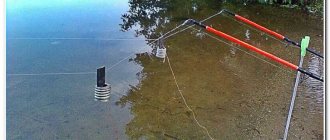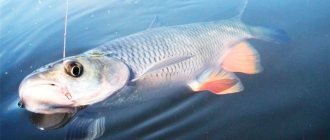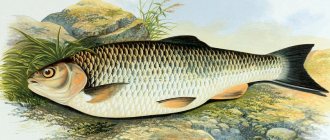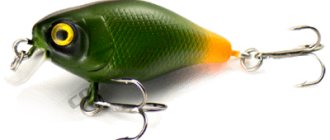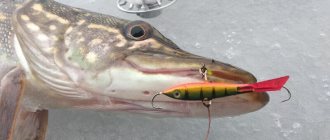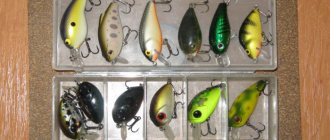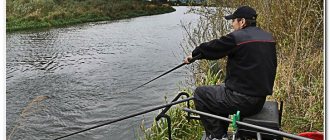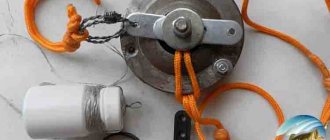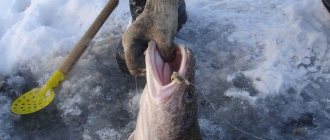One of the options to diversify the fishing process is to try to catch such an unusual fish as a chub. If you use a donk, you can even catch quite massive fish. The main distinguishing feature of this tackle is that it does not have a float. Fishermen determine whether a fish has caught the bait only by the degree of tension of the fishing line itself or by the hesitation of the guard.
The article gives advice to novice fishermen on how to organize such a complex fishing for this fish.
Features of catching chub on a donk
Content
Chub fishing is different due to the energy and strength of the fish, which can cause a lot of trouble if not properly prepared. When fishing from the shore, we recommend that you think about high-quality fastening of your rods so that they do not get pulled into the pond. Even with a good fastening, the fisherman’s reaction still remains an important component. When fishing, it is important to behave confidently, preventing burying in reeds and underwater snags. To get the catch out of the water, it is better to use a landing net.
Fishing for chub on a feeder is most relevant on rivers with fast currents. The fish loves streams of water and is found in the beds of such reservoirs closer to the shore. More often, prey is found near bushes, trees, and reeds. The largest number of fish and trophy specimens are found in clean, cold water.
A promising fishing spot is indicated by the presence of small chubs that chase fry along the surface of the water. They love to collect various delicacies from the surface: beetles, larvae, grasshoppers. You can identify the fish by the appearance of small things scattering on both sides.
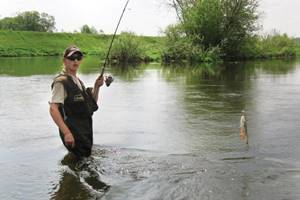
Catching chub on a donk is characterized by an incredible sense of excitement and adrenaline
Due to the nature of the habitat, it is better to use places from which casting along the current is possible for chub fishing. If you fish across, the bottom tackle you make will begin to get very tangled due to it being carried away by the current and coming into contact with aquatic vegetation. When fishing longitudinally, the donka for chub will not get tangled and will be fixed in one position without any displacement.
If there are no chub bites for a long time, we recommend trying to pull the tackle 1-2 m towards you. This helps make the bait more visible, as there is a risk of getting into unsuitable terrain where the chub will not notice the bait. With a submersible, you can catch more fish because the bait becomes more visible.
Catching chub in the spring on a donk is relatively simple, although the fish has excellent vision and hearing, combined with high activity, the prey is prone to aggressively capturing the bait. In summer and autumn, the fish becomes even more energetic and less cautious. In each case, in the presence of noise on the shore, chub fishing becomes ineffective. Pisces loves neat behavior without unnecessary fuss.
Read more
Models and characteristics of Halko wobblers
For such prey, it is better to use self-hooking gear, since determining the hooking time is difficult even for an experienced fisherman. When the prey feels pressure, it will begin active resistance, and especially often likes to move the tackle to the side. To make it easier to remove the prey, we recommend letting it get exhausted, and then gradually pulling the line towards you.
Lure
The baiting process does not particularly affect the fishing result when it comes to chub. Experienced fishermen recommend simply throwing the bait after choosing a good place with a large number of fish. But still, in some cases, bait can help in catching. In this case, the shore will not play a big role; here everything depends on the behavior of the fish depending on the time of year.
For example, complementary foods in the spring should consist of animal parts, but in the summer it is better to focus on plant options. In the case of the animal part of complementary feeding, it is recommended to choose minced chicken liver or chopped worms. You can add sand or soil to this mass, but only if the mixture is too viscous. If plant components are chosen as bait, then it is best if they are beans or cereals. Large parts will help to sweep away small fish and attract larger individuals (wheat grains or pearl barley are suitable here).
Tackle for catching chub on donka
Making a donk for a chub is not difficult, guided by the basic principles:
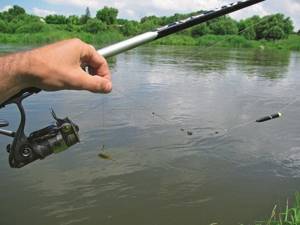
The main difference between the gear is the absence of a float; you can find out about a bite by the tension of the fishing thread or by the intense vibrations of the guard
- rod The best choice for a fishing rod is a fiberglass rod - it is light, durable and wear-resistant. It has everything you need to successfully fish even a particularly large trophy. The choice is made taking into account fishing conditions, usually the test is in the range of 60-180 g;
- fishing line, thread. All fishing gear must take into account not only the impressive size of the prey, but also its strength, which leads to the need to take fishing line with a reserve. It is better to take a closer look at options with a diameter of 0.35 mm or more. The braid is taken 0.2 mm. The shock leader is selected from fluorocarbon (monofilament fishing line is also suitable) with a length of up to 10 m. It is preferable to buy fishing thread from a well-known manufacturer, but other gear from less popular companies also brings good results;
- coil. Experienced fishermen prefer a powerful and reliable reel, preferably a multiplier reel. Before purchasing it, a simple “meat grinder” will do. The main thing is the convenience of delivering the tackle to a specific point and ease of fishing. Inertia-free options perform better;
- sinker. To prevent the tackle from being carried away by the current, use sinkers of streamlined shapes, often in the form of an oval. Such a load is resistant to being washed away by a stream of water and does not create an unnecessary obstacle when casting. Weight depends on the fishing method and the intensity of the current. Initially, set a 30 g sinker; if it is not possible to securely fix the tackle with it, increase the weight by 10 g. This is done until an option is found in which the bottom will be resistant to washing off;
- hooks It is preferable to use large hooks, since the opponent has a tendency to swallow the bait completely with his large mouth. It is important to have several hooks with you, all with a small shank;
- bite alarm. For a good bite, it is enough to use a primitive bell. It rarely makes false signals and creates a sound that can be heard from a distance of up to 5 m.
Bottom tackle, wobblers and any other bait for chub are attached using rigs: helicopter and 2 knots (the most common), asymmetrical loop, paternoster, inline.
Gear selection
The fisherman’s equipment also plays an important role in organizing fishing. In practice, various types of gear are used. All of them can be divided into two large groups: passive and active. Passive ones often mean cords, cords, and, of course, donuts with rubber shock absorbers. However, the rubber band will not work in a current area.
It is best to start collecting gear directly on the river. Be sure to have with you such components as fishing line, sinkers and hooks. Donka is a tackle that anyone can assemble with their own hands (you can find a large number of training videos on this topic on the Internet). The tackle itself is compact and functional. However, if in the summer and spring fishing with such a donkey will bring true pleasure, then in the fall it will not be so interesting. Therefore, in cold seasons it is better to opt for active gear.
Representatives of this group include a feeder - it can be purchased at a specialized store for fishing and hunting. If a fisherman still uses a donkey, then it must be equipped with a fishing rod. There is also an unusual version of such gear - half-bottoms. They look like fly rods with the float at the very tip. To catch a chub you will need quite powerful devices due to its weight. It is better to choose gear 1.5-2.5 meters long. In some cases, spinning rods can be used.
Read: How to choose a catchy wobbler for chub. Review of popular models
Catching chub on a donk depending on the season
Successful donk fishing is possible only if you have knowledge of the behavioral characteristics of the prey. Fish change their habits at different times of the year.
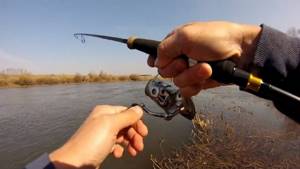
You can catch a beautiful and strong chub only if you know its habits relative to the time of year.
To catch a beautiful, large specimen, consider the behavior of prey in different seasons:
- spring. Catching chub with a donk in the spring is most successful during the spawning period, since the predator is most active. There is no clear date when chub begins to be caught in the spring on the bottom; more often the bite improves after the water warms up a little. In April and even March, fishing is especially productive due to the tendency of fish to constantly search for food. She spends almost all her time searching for food on the surface of the water, and yet catching chub in early spring on a donk is most effective at the first and last dawn. Now it’s worth lengthening the leash to 0.8-1.5 m and installing light bait that will float on the surface;
- summer. The predator is highly active in the summer; its places of accumulation are overhanging trees, where it waits for insects to fall from the leaves. For a good bite, we recommend throwing the bottom into a place where the water flow slows down, where there is a boundary between currents of different strengths. The chub is hooked mainly in July and August, when it rises especially high to the surface of the water. When the air temperature is above 30-35°C, the fish begins to feed more actively in the dark, therefore, it is worth catching it at night;
- autumn. The prey is still active, the chances of catching the prey remain very high. It is important to understand that starting in September the temperature gradually decreases, which forces the fish to move away from the shore into deeper water layers. Gradually, morning fishing fades away, and fishermen are left without a catch. The best results are shown by fishing after 10 am in a warm reservoir;
- winter. Chub hunting in winter is quite possible, but only at relatively warm temperatures, when there is no thick layer of ice on top. At temperatures of -20°C and below, fishing is pointless; the chub is not interested in any bait; it descends into the pits. Donka for chub in winter brings good results when the first ice appears, as the fish remains active, but at the same time extremely cautious. To get the loot, you need to minimize fuss and conversations; hitting the ice is strictly prohibited.
Read more
How to make a “crucian carp killer” tackle: DIY production and fishing techniques
Tackle
The equipment in the situation under consideration also has its own characteristics. There are quite a lot of varieties of gear. They, in turn, are divided into active and passive. The latter variety includes hooks, cords, releases, vents, as well as donks with rubber shock absorbers. It is worth keeping in mind that the so-called rubber band does not work in the current.
When used correctly, it is possible to assemble the device directly on the river. The condition is the presence of sinkers, fishing line and hook. Using videos from the Internet, you can learn how to make a donka with your own hands. This is a fairly functional and compact device. In September or any other month it will not be interesting enough to fish using the specified device.
Active gear is presented:
- Feeder. Such a device can be purchased at a special store.
- Donka may have a fishing rod.
- There are also half bottoms. It is represented by a fly or Bolognese fishing rod, on which the float is shifted to the tip.
To catch said fish, you will need to use a powerful device. The length of the device should vary from 1.5 to 2.5 meters. When fishing, spinning rods made of duralumin and telescopes made in China are used.
For moderate flows, feeders classified as heavy class are used. The maximum length is then 3.3 meters. Donka can be presented in the form of a spinning rod. In this case, the coil must be powerful and reliable. The volume for the spool is set to at least three thousand sizes. To ensure that the rod does not fall from the stand, the mechanism must be correctly configured to avoid unwinding in the stream.
Chub fishermen most often use a monk. Experts say that high information content is not needed when catching such fish, so there is no need to use a fence. Due to the shock-absorbing properties of monofilament, it will allow you to throw heavy loads without any worries.
Experts point out that the optimal size is considered to be from 0.28 to 0.35 mm. It is not recommended to use smaller monofilament threads due to the risk of snagging. In turn, a thick thread, due to its windage, leads to the displacement of even a load with a mass of 200 grams.
When fishing for chub, hooks assigned to numbers from 8 to 12 are used. These numbers are related to Russian numerology. This fish can easily swallow a hook number 10. For this reason, they say that when choosing gear you should pay attention to the size of the bait, regardless of the size of the fish itself.
Preference should be given to hooks equipped with a long shank. They allow a person to set bait that has volume. It will be easier for the fisherman to hook the fish himself using such a device.
It is worth paying special attention to the fact that the species of fish in question has quite powerful teeth. Therefore, it is not recommended to remove the hooks from the throat with your hands. Otherwise, the fisherman risks injury.
To tie the leash, a fishing line is used, which consists of fluorocarbon. Experts point out that it is best to use a leash whose diameter is from 02 to 0.25 mm. The length of such a device should vary from 40 to 60 cm. If some types of attachments are used, then a leash with a length of 80 cm can be used.
Requirements are established regarding the sinker so that it matches the bottom topography. If we talk about the bottom, where there are pebbles and sand, then you need to use a flat weight that looks like a spoon. This is due to the fact that such devices provide better adhesion to the bottom coating.
If areas of the bottom have snags or stones, then olive-shaped weights are used to prevent them from getting caught. The figure can also be like a cylinder.
Donkey baits and bait for chub
Lures for chub in the spring on donka should take into account the predatory tendencies of the fish, although plant baits are also effective. It would be more correct to call it an omnivore. In each water area, the inhabitants have their own dietary preferences; it is better to prepare several types of bait with you in advance.
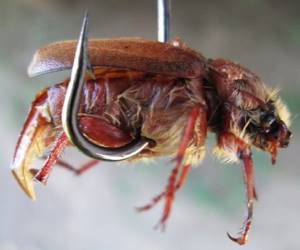
You can identify your favorite bait through experimentation, throwing several bait options at once.
The best catches were spotted on:
- various worms (white and red);
- larvae of beetles (bark beetles, beetles, flies). Bites are frequent, but mostly small specimens are caught. It is important to remove the wings of the beetle, this will create additional attractiveness for the bait;
- dragonfly larvae are a favorite delicacy from mid-spring to July;
- small toads It is the most effective bait for large chubs;
- maggots;
- corn grains do not create much interest from small animals, but attract large individuals;
- bloodworm;
- live bait;
- bread;
- insects - all kinds of grasshoppers and bloodworms are more attractive in summer.
Only experimentally it is possible to determine the most catchable bait. Taste preferences tend to change even over time. So in the summer, prey prefers food that falls from trees; it is better to use mayfly. In autumn, it is preferable to use protein baits.
It is advisable to use bait; it is immediately delivered to the fishing spot, and then gradually only thrown in. Mixtures are prepared with the addition of steamed grain, bread with hemp grains, linseed oil, etc. At the stage of casting gear, the best results are achieved by aromatic mixtures with bran and corn flour.
Choosing a place and time of day for catching chub on a donk
More often, the desired prey is found in small and medium-sized rivers with clean water. More promising areas in such water areas are:
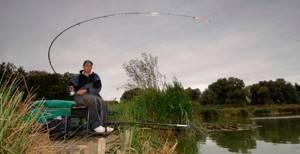
Considering that the chub prefers to live in areas with fast currents, where hooks often get caught in aquatic vegetation, it is advisable to choose places more suitable for casting
- cliffs;
- trees hovering over the water and providing food for the predator;
- whirlpools;
- places with fast currents;
- areas on the border between intense and weak currents;
- areas with noticeable active movement of fry.
The fishing season begins in March and ends in severe cold. The greatest activity is observed in summer. During the day, it is easier to find prey on the surface, and in the evening - closer to deep places. To catch a trophy specimen, it is better to come at night (in warm weather). In early spring and late autumn, prey is more often found on the hook during the day. It is worth fishing with bottom gear at night.
Read more
How to catch crucian carp on a donk?
Tactics and techniques for catching chub on a donk
Fishermen have been practicing techniques for catching chub using spinning rods, donks and other gear for decades, but now there is no need for practical experience, since there are already collected recommendations.
How to catch chub on a donk in the current, according to experts:
- use only 1 tackle, otherwise the current will confuse the fishing line and you should not expect productive fishing. If you use 2 gears, be sure to adjust the friction brake.
- send the donkey only along the current, ensuring a stable position;
- if the fish does not bite, it is recommended to shift the nozzle in the water column, it is better to raise the tackle by 50 cm and again wait for a reaction;
- change the place of fishing if there are no bites for a long time. The fish is standing nearby, just move 10 meters above or below the current point;
- At the preparation stage, you should stock up on 2-4 gear and types of bait.
Bottom gear
Among the bottom tackles for chub, it is necessary to separately highlight donks based on spinning rods and modern English fishing rods - feeders. The use of each of them requires its own equipment and fishing tactics.
Donka from a spinning rod
This tackle appeared shortly after the invention of fishing reels, allowing anglers to make long casts. Simple hooks gradually faded into the background, and are now used mainly as hooks set at night for catching burbot or catfish.
To complete a simple rod with a reel, the following elements are used: 1. A powerful spinning rod with a large cast, allowing you to cast heavy equipment. Currently, the well-known Chinese “crocodiles” and similar sticks are widely used in this capacity.
2. An inertia-free reel that holds a sufficient amount of thick fishing line, according to Shimano-Daiwa, its size is 3000–5000 units.
3. Monofilament fishing line 0.25–0.30 millimeters. Its breaking load should allow you to throw a load suitable for fishing in the conditions of your river.
On a note! Some fishermen use braided line, like on a feeder, to cast their rigs longer. In this case, it is recommended to use a shock leader 2–3 rod sizes long.
4. A sinker or feeder according to the season with its own weight, which allows you to hold the equipment at the selected point. On quiet rivers, sometimes 40–50 grams is enough, but sometimes 120 grams is not enough.
5. A rig with two to three leashes located above the sinker at intervals of 20–30 centimeters.
Donners who use such gear usually use 3-4 fishing rods at once, believing that in this case the probability of a bite is higher. They are installed 5–10 meters from each other and equipped with bells during daylight hours or fireflies for night fishing.
Feeder
Catching chub on a feeder differs greatly both in the selection of gear and in the tactics of the process. What immediately catches your eye is the elegance of the tackle compared to the classic donka. It comes complete with:
- A feeder rod of the test class that can be used on a specific river: the weight range can be from 60 to 180 grams.
- A spinning reel balanced with a specific feeder.
- Braided cord with a thickness of up to 0.20 millimeters, its breaking load should be lower than the test of the line form.
- Shock leader made of monofilament or fluorocarbon, 6–10 meters long.
- Feeder installation.
- Leash with a hook for fishing conditions.
Chub on a feeder requires the use of the following equipment:
- asymmetrical loop;
- paternoster;
- Gardner loop;
- inline;
- helicopter and two knots.
The “helicopter” rig is especially often used in chub fishing; it allows you to vary the height of the bait in the water.
Feeder fishing tactics are common for this English gear:
- reconnaissance of the river bottom profile in search of a catch point;
- pre-feeding;
- casting to a fed point.
By the way! You can put the toughest tip on the feeder; a chub bite cannot be missed due to the sharpness of the fish.
Recommendations and tips for catching chub on a donk
There are some other useful tips for catching chub using a donkey:
- strong fixation on the shore. The desired prey tends to suddenly and greedily grab the bait; if you do not tie the fishing rod, it will fall under the water. While pulling out the rod, the fisherman will scare away the entire potential catch;
- maintaining silence. The predator's hearing is well developed, a frivolous attitude towards fishing will lead to a lack of catch;
- not to be near the gear. The eyes of a fish instantly notice a person; you should not walk near fishing rods or approach them at all. It is better to move a distance away from the donkey or hide behind the bushes.
The chub is a predator that is used to fighting for its life. Its capture attracts fishermen because of the amount of adrenaline and emotions in the process of fishing. Catching a wary fish is difficult without special knowledge, but using the tips outlined above, the fishing process will become extremely effective and enjoyable.
Originally posted 2018-07-09 14:06:11.
Bait
It is very difficult to make an exact list of the most suitable bait, since the tastes of fish can change. It all depends on the reservoir where the chub lives, as well as the time of fishing. Experienced fishermen recommend using the following bait options:
- Animal liver;
- Lampreys;
- Shellfish;
- Frogs.
From this entire list, special attention should be paid to the lamprey, because... Fish will never miss this delicacy. You can fish all year round to catch this fish if you use lamprey larvae or lamprey itself as bait. This creature can be dug up using a special bucket, and its shape resembles a fish. To prolong its life and prevent it from going into the ground, it is better to bait it through one hole.
Read: Feeder equipment
